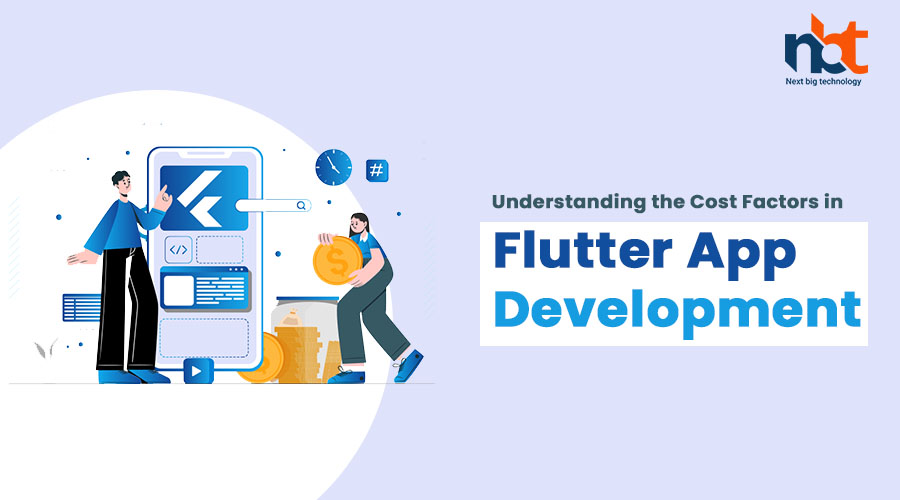Introduction: Flutter, an open-source UI software development kit (SDK) created by Google, has gained significant popularity for its ability to build cross-platform mobile applications with a single codebase. As businesses and developers consider leveraging Flutter for their app development needs, understanding the cost factors associated with Flutter app development is crucial. In this blog, we will explore the various factors that influence the cost of developing a Flutter app, enabling you to plan and budget your project effectively.
- App Complexity: The complexity of your app is a significant factor in determining the development cost. Apps can range from simple utility or informational apps to complex enterprise-level applications with extensive functionalities. The more features, screens, and customizations your app requires, the higher the development cost will be. Complex features like real-time data synchronization, integrations with third-party services, payment gateways, or AI/ML capabilities will contribute to the overall complexity and cost.
- Design and UI/UX: Investing in an appealing and user-friendly design is crucial for the success of your Flutter app. The cost of app design and UI/UX development depends on the complexity of the design, the number of screens, and the level of customization required. If you already have a design in place, it can reduce the cost compared to starting from scratch. However, if you require professional assistance from UI/UX designers, it will add to the overall development cost.
- Development Team: The cost of building a Flutter app also depends on the size and expertise of your development team. Factors such as the number of developers, their experience level, and the duration of the project will affect the overall cost. Hiring experienced Flutter developers may come at a higher cost but can contribute to a more efficient and high-quality development process. Additionally, consider the need for other roles such as project managers, quality assurance testers, and UI/UX designers, as they will also impact the development cost.
- Backend Development: Flutter apps often require a backend infrastructure to handle data storage, authentication, API integrations, and other server-side operations. The cost of backend development will vary based on the complexity and scalability requirements of your app. If you choose to build a custom backend using frameworks like Node.js or Django, the development cost will be higher compared to using backend-as-a-service (BaaS) solutions or integrating with existing APIs.
- Integrations and APIs: If your Flutter app requires integration with third-party services like payment gateways, social media platforms, analytics tools, or other APIs, the cost will be influenced by the complexity and number of integrations. Some integrations may require additional development effort and configuration, which can contribute to the overall cost. Additionally, consider the ongoing maintenance and potential costs associated with API usage or licensing fees.
- Testing and Quality Assurance: Ensuring the quality and reliability of your Flutter app is essential. The cost of testing and quality assurance activities depends on the scope of testing, the number of devices and platforms to support, and the level of testing automation. Thoroughly testing your app for functionality, usability, performance, security, and compatibility with different devices and operating systems will contribute to the overall cost.
- Maintenance and Updates: After launching your Flutter app, ongoing maintenance and updates are necessary to address bug fixes, security patches, compatibility issues, and to introduce new features or enhancements. The cost of maintenance will depend on the frequency and complexity of updates, as well as the need for support and ongoing monitoring.
- Timeframe and Project Management: The timeline and project management approach can impact the overall cost of Flutter app development. Tighter deadlines or accelerated development schedules may require additional resources and effort, potentially increasing the cost. Efficient project management, communication, and collaboration tools can help optimize the development process and minimize costs.
- App Store Deployment: Submitting your Flutter app to app stores like Google Play Store and Apple App Store involves a cost. Both platforms charge a one-time fee for app store registration. Additionally, consider any marketing or promotional expenses required to increase app visibility and downloads once it is live on the app stores.
Conclusion: Developing a Flutter app involves multiple cost factors that need careful consideration. App complexity, design and UI/UX, the development team, backend development, integrations, testing, maintenance, timeframe, and app store deployment are key factors that influence the overall cost. By analyzing and understanding these factors, you can effectively plan and budget for your Flutter app development project. It is crucial to strike a balance between cost and quality to ensure a successful app that meets your business objectives and user expectations. Collaborating with experienced Flutter developers and project management professionals can help optimize the cost while delivering a high-quality app that delights your users.










